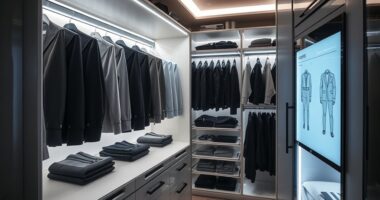3D body scanners are highly accurate tools for custom fit orders, capturing detailed measurements within millimeters and ensuring consistent results. They use advanced technology like multiple cameras and structured light to scan your body from various angles, reducing errors caused by clothing or posture. With proper calibration and minimal clothing, you can expect precise fits. Keep exploring to discover how ongoing advancements are making these scans even more reliable and beneficial for your custom garments.
Key Takeaways
- High-end 3D body scanners achieve measurements within millimeters of actual body dimensions.
- Multiple cameras and advanced algorithms minimize errors and improve measurement accuracy.
- Proper clothing, posture, and calibration are essential for optimal scan precision.
- Continuous technological improvements enhance reliability and reduce inaccuracies over time.
- Scanners are suitable for precise tailoring, sportswear, and custom garment fitting.

3D body scanners are transforming how you order custom-fit clothing and accessories by providing precise body measurements in seconds. This technology is revolutionizing the way you approach garment fitting, making it faster and more accurate than ever before. Instead of relying on traditional measuring tapes or guesswork, the scanner captures a detailed 3D image of your body, ensuring that every measurement is exact. This level of accuracy helps you achieve a perfect fit, reducing the frustration of ill-fitting clothes and the need for multiple adjustments.
When it comes to sizing consistency, 3D body scanners excel. Because they generate detailed, repeatable measurements, you can be confident that your clothing will fit the same way every time—whether you’re ordering a new piece or reordering a favorite item. This consistency is especially important in custom clothing, where small variations can affect comfort and appearance. The scanner’s ability to produce standardized measurements minimizes discrepancies caused by human error or subjective interpretation, giving you confidence that each garment will meet your expectations.
The accuracy of 3D body scanners depends on several factors, including the quality of the device and the scanning process itself. Most high-end scanners use multiple cameras and structured light or laser technology to capture your body’s contours from multiple angles. This multi-view approach ensures a detailed, comprehensive model, reducing the chances of measurement errors. Many scanners also include calibration routines and software algorithms that refine the data, increasing overall precision. As a result, the measurements you receive are typically within millimeters of your actual body dimensions, making them reliable for designing custom clothing.
Furthermore, advancements in scanner technology continue to improve measurement precision and reduce potential inaccuracies caused by variables like clothing or posture. However, some variables can affect measurement accuracy. Factors like clothing worn during scanning, your posture, or movement can introduce minor inaccuracies. To get the best results, you’ll want to stand still and wear tight-fitting, minimal clothing during the scan. The environment should be well-lit, and the scanner should be properly calibrated. When these conditions are met, the technology consistently produces measurements that are highly accurate, making it suitable for tailoring, sportswear, and other custom garments.
Frequently Asked Questions
How Long Does a Typical 3D Body Scanning Session Last?
A typical scan duration usually takes about 30 seconds to a few minutes, depending on the scanner’s technology and the level of detail needed. During the session, you’ll stand still as the scanner captures your body measurements. The session length is quick, often less than five minutes, making it convenient for most users. You’ll find that the efficient scan duration allows for fast, accurate results without much hassle.
Are 3D Body Scanners Safe for All Skin Types?
You might wonder if 3D body scanners are safe for all skin types. Generally, they are safe, but if you have sensitive skin or skin conditions, it’s wise to verify with the provider. These scanners use low-energy light, so skin sensitivity isn’t usually an issue. Also, guarantee your data security is prioritized, as personal measurements are collected. Always ask about privacy policies to protect your data during the process.
Can 3D Body Scans Be Used for Medical Diagnosis?
Imagine a lighthouse guiding ships safely—3D body scans hold similar promise in medicine. While they show excellent medical accuracy for measuring and monitoring body changes, their diagnostic potential is still emerging. You can’t rely solely on them for diagnosis yet, but they assist doctors as a valuable tool in evaluating health, tracking progress, and supporting medical decisions. As technology advances, their role in diagnosis will become even clearer.
What Are the Privacy Measures for Stored Scanning Data?
When it comes to your stored scanning data, privacy measures are essential. You should know that companies use data encryption to protect your information from unauthorized access. They also implement strict access control, ensuring only authorized personnel can view or manage your data. These measures help keep your personal details safe and confidential, giving you peace of mind knowing your privacy is prioritized and secure.
How Often Should I Redo a Scan for the Best Fit?
Did you know that updating your scan every 6 to 12 months can considerably improve fit accuracy? To get the best fit, you should consider scan frequency based on your body changes, activity level, and weight fluctuations. Regular scans help guarantee your clothing fits perfectly over time. If your body shape shifts or you lose or gain weight, redoing the scan sooner will maintain ideal fit accuracy.
Conclusion
Using 3D body scanners can substantially improve the accuracy of custom fit orders. For example, imagine ordering a tailored suit that fits perfectly because the scanner captured your exact measurements. While no technology is flawless, advancements continue to make these scans more precise. So, if you’re considering custom clothing, investing in a 3D body scanner could mean fewer returns and better comfort—making your perfect fit just a scan away.






